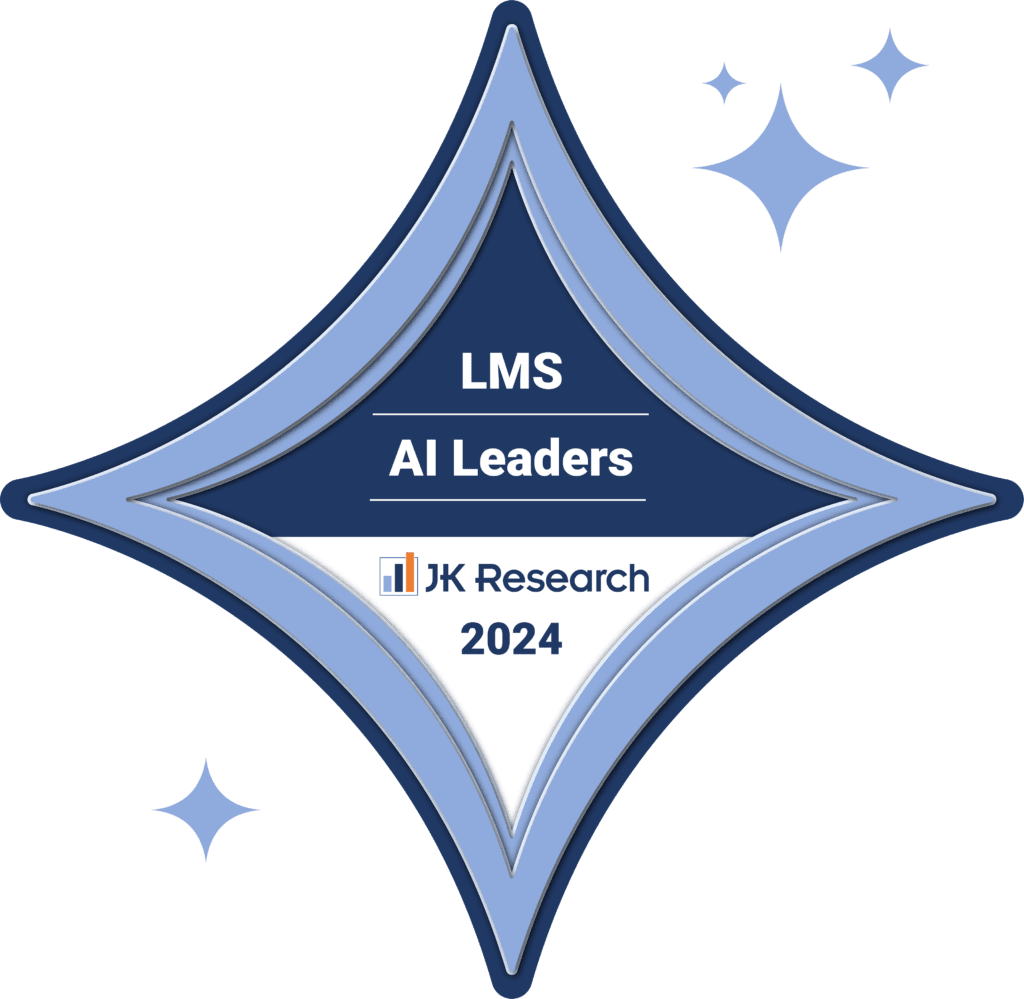AI. For some time, artificial intelligence has been touted as the future of various industries. Learning and development is no different.
The coming year is one in which AI is set to truly revolutionise the learning and development industry. Keep on reading to find the seven ways in which AI is set to change the future of L&D in 2023… ???
AI and L&D: what does it mean?
Ask many people to think of the various applications that artificial intelligence could be used for, and learning and development is probably not the first thing that’ll spring to their mind.
However, the truth is that AI and L&D are a match made in heaven! ??
As you’ll see, learning and development – and the skills and knowledge that this discipline tries to impart – will be greatly aided by the introduction of AI into learning and development platforms. ?
This means that if you’re not currently using a learning platform that utilises AI, you need to start using one that does – or else you and your company risk being left behind in 2023 and beyond…
How AI will transform learning and development
So, on to the seven ways in which artificial intelligence will transform L&D in 2023 and beyond. Trust us, you’ll be surprised at how transformative AI promises to be! ??
1. Enhancing understanding
How do you teach something that you only have a passing familiarity with? Well, with great difficulty! ?
No matter how much you try, it’s unlikely that as a learning and development professional you’re going to be able to accrue the same level of knowledge as the subject-matter experts within your business.
The traditional route has been to try to interrogate subject-matter experts and get all of that knowledge out of their heads and into your training materials. ✏️
But, as any seasoned L&D professional will tell you, doing this is far easier said than done.
The reality is that precisely because your subject-matter experts are… well, experts, they’re in demand and focusing on their day jobs.
In the past, this meant that their knowledge stayed in their heads, and training materials lacked the depth and detail needed to truly pass on their knowledge. ??
But it doesn’t have to be this way! ??
The new generation of AI-enabled learning experience platforms (LXP) can do the hard work for you and absorb the learning of the topics that your subject-matter experts are specialists in.
AI is able to read, watch and listen to content and gain a contextual understanding of a topic. ?
Not only does this result in better, more relevant learning materials for learners, but it frees up time for L&D professionals (and subject-matter experts) to focus on other value-add activities. To put this into context, a report by Udemy in 2021 found that 61% of L&D professionals reported lack of time as one of the biggest challenges they face. AI can – and will – help solve this issue. ⏱️?
2. Personally curated learning pathways
With an AI-based Learning Platform, you’ll be able to provide your employees with personally curated learning pathways.
Instead of the traditional learning route – which involved providing learners with generic learning materials that included much irrelevant material – AI can help create high-impact, highly-relevant learning pathways. ??
How? Because an AI-enabled LXP will remember an employee’s previous interaction with the platform, learn from this, and only offer up relevant training materials based on these previous interactions.
After all, every individual has different ways of learning. They’ll respond better to certain content formats. They have preferences in how and when they learn.
AI-enabled LXPs accommodate this, creating a learning experience that is; more engaging, more relevant, more efficient, and more likely to result in improved learning outcomes.
Don’t just take our word for it, though! Consider that 77% of L&D professionals say that personalised learning experiences are essential to employee engagement (according to a survey carried out at the Learning Technologies exhibition). ????
Here at Thirst, we strongly believe in the power of curated learning experiences, which is why the Thirst platform allows you to upload any file, from anywhere. Be it a video, text, or audio file, Thirst allows you to create a central hub of resources – and even assign them to individual users!
3. Improved access to learning materials
Older learning management systems (LMS) often struggled to offer up relevant learning materials to users in response to search queries.
These platforms typically relied on Boolean search operators in order to identify content (in response to a query), and to be frank – the results they served up were generally less than impressive. ???
AI turns this situation on its head thanks to the power of natural language processing. This means that AI is better able to A) understand the intent behind a search query, and B) better able to scan and read learning materials, develop a contextual understanding of what they are about, and C) offer them up as a search result. ??
This final result is a situation where searchers are given much more relevant results to their search queries, resulting in better engagement, and better learning outcomes. ??
In other words – they’ll have access to the learning materials they actually want!
When you consider that 49% of employees say they don’t have time to engage with learning materials (according to LinkedIn’s Workplace Learning Report 2020), anything that reduces barriers – such as improved access to learning materials, via AI-enhanced search results in learning platforms – is bound to improve this situation. ?✨
4. On-demand learning
Why do your employees have to undertake learning in certain locations and on certain devices? ??️
In a world where people are able to work, shop and play across multiple devices in multiple locations, it no longer makes sense to restrict your employees’ learning to an old-school L&D suite or a desktop terminal in the workplace.
Today, employees want to be able to access learning materials in multiple content formats, in different locations, on myriad devices. ?
AI allows you to provide exactly that kind of learning experience, as AI tools can understand the flow of work, providing learning recommendations based on where you are and what you require in that context.
Given that 69% of employers are struggling to recruit skilled workers (as per research carried out by the Manpower Group), anything that will help to upskill workers – such as on demand learning – will provide employers that have invested in AI-enabled Learning Platforms a significant competitive advantage in the war for the best talent. ?❤️
5. Faster learning
AI can radically speed up the learning process – upskilling your workforce more quickly and improving productivity.
How? Because AI can use natural language processing (NLP) to analyse and synthesise written words. This means that a learning experience platform that makes use of AI – such as Thirst – can understand what an employee is typing. ⌨️?
It’s not merely a superficial understanding, either. AI can identify what keywords have been used, how many times fillers or irrelevant/incorrect words have been used, and what choice of words have been used. AI can also understand tone of voice, sentiment and more. ??
And, here’s the kicker; an AI-enabled Learning Platform can not only build up an understanding of employee inputs, but can also provide real time feedback, identifying areas where an employee needs to improve.
As you can imagine, this drastically speeds up the learning process. Employees can receive instantaneous feedback and learn from it. L&D professionals, meanwhile, will have less manual assessment and analysis to undertake. Win, win! ??
AI-enabled learning platforms can also help L&D professionals identify common weaknesses or gaps in knowledge amongst employees. For example, AI-based learning platforms can let L&D professionals know when the majority of test takers answered a particular question incorrectly. ❌❌
6. Improved measurement
Back in the pre-AI age, only around 15% of employees would complete their training programmes.
When you consider the time and investment that goes into L&D at many companies, this is a shockingly small percentage. ????
AI-enabled learning experience platforms like Thirst change this. AI is better able to parse and sort data, and can identify not only macro-level learning trends across your whole workforce, but also micro-level learning trends amongst individual employees.
AI is also set to change the way education and learning content is produced. Why? Because of its use of machine learning and natural language processing, AI is better able to identify which content formats are most effective for your employees. ✋✋
As such, AI is set to change the types of content L&D professionals are creating in 2023 and beyond. If you don’t want to get left behind, then it’s time to upgrade to an AI-enabled Learning Platform!
7. Generating more value from your existing L&D investments
Without doubt, your organisation probably has hundreds – maybe even thousands – of pre-existing learning and development materials.
These could be manuals, articles, slide decks, videos, or podcasts. But, all too often, these learning assets are not accessible to workforces in any meaningful way. ??
Not only can these assets be hard for employees to search and find, but they can be hard to digest – for example, there are unlikely going to be many employees who can spare the time to watch an hour-long video. ⌛
AI changes this by analysing, understanding and recontextualising this content. In other words, an AI-enabled learning platform can take your pre-existing learning content and turn it into an easily accessible, centralised learning hub that is much more likely to be used by your employees. It can also help you identify content that would work better in a shorter, more digestible format.
In this way, AI can help organisations to get much more value out of learning materials in which they have previously invested. ??
Thirst: the AI learning platform of choice
If you like the sound of what AI could do for your workforce’s learning and development, then choose Thirst.
Dive into the ultimate learning experience with instant unlimited access on a 14-day free trial. ???
Try Thirst today
For more e-learning news, advice and information, read the Thirst blog…
What Is the Difference Between Knowledge and Skills? | Track Learning Progress and Identify Knowledge Gaps | Blended Learning Can Be a Solid L&D Strategy – Here’s Why







